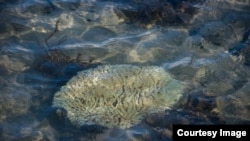The Great Barrier Reef, which runs along the northeastern coast of Australia and is three quarters the size of California, is facing what is being described as the “worst mass bleaching event in its history.”
Using aerial surveys of more than 500 reefs stretching north of Cairns, the researchers said the majority of the reefs ranked in the most severe bleaching category.
“This has been the saddest research trip of my life,” said Terry Hughes, convenor of the National Coral Bleaching Taskforce. “Almost without exception, every reef we flew across showed consistently high levels of bleaching, from the reef slope right up onto the top of the reef. We flew for 4,000 kilometers in the most pristine parts of the Great Barrier Reef and saw only four reefs that had no bleaching. The severity is much greater than in earlier bleaching events in 2002 or 1998.”
Bleaching happens when, for example, sea temperatures rise, according to the National Coral Bleaching Task Force. The higher temperatures cause the coral to “expel” colorful photosynthetic algae, and as a result, the coral turns white. The process could be reversed if the water temperature falls, allowing the algae to recolonize the coral.
If this does not occur, the coral could ultimately die.
“Scientists in the water are already reporting up to 50 percent mortality of bleached corals,” said Hughes, “but it’s still too early to tell just what the overall outcome will be. We will continue to conduct underwater surveys along the Great Barrier Reef in the coming months as the full impact of this mass bleaching event unfolds.”
Hughes added that most of the severe bleaching was in the northern part of the reef, saying the southern part “dodged a bullet” thanks to “cloudy weather that cooled the water temperatures.”
Hughes said the bleaching was likely made worse by the strong El Niño event in the Pacific Ocean.
According to The Washington Post, there have been three observed mass bleaching events - in 1998, 2010 and this year. All three correspond to El Niño.
The Great Barrier Reef is listed as a UNESCO World Heritage site with more than 400 species of coral and 1,500 kinds of fish. It is the only reef designated a Heritage site.
Australia’s Great Barrier Reef Marine Park calls it the largest living structure on the planet.












